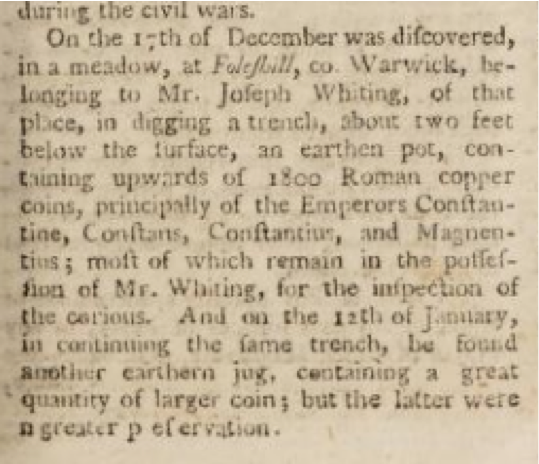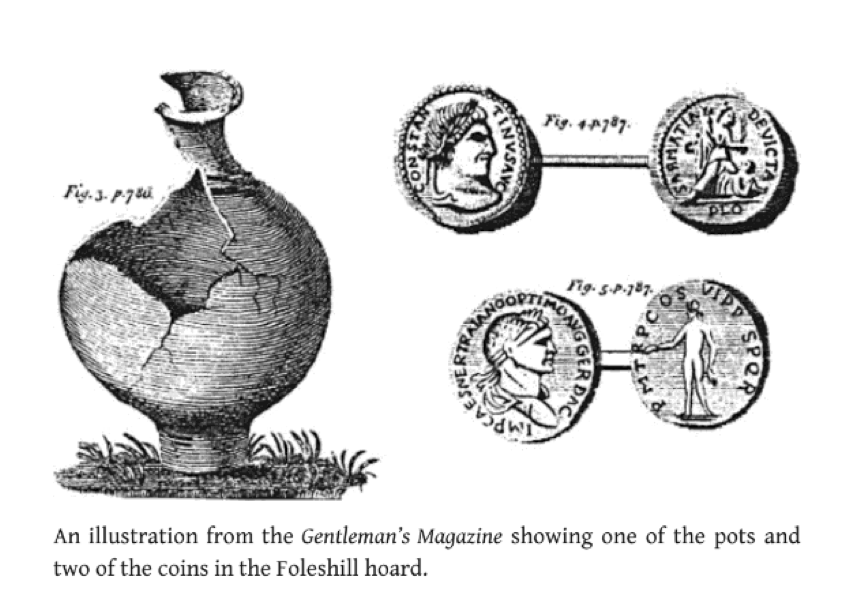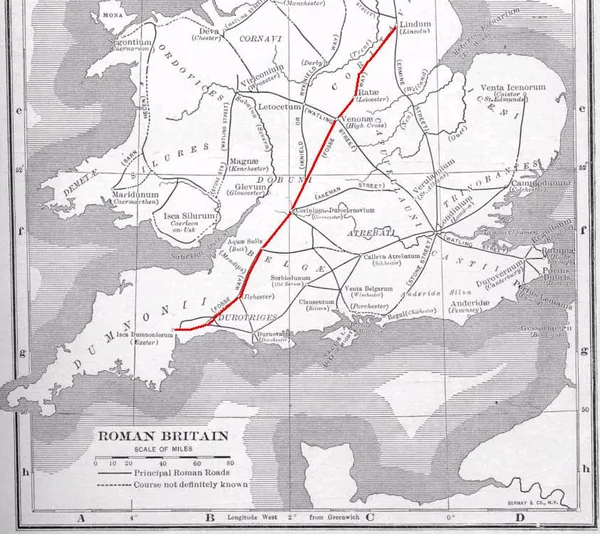An A-Z of Roman Coventry: F-M

Foleshill Coin hoards
SP 3500 8200
Gentleman’s magazine 1793.
17th December, 1793, in meadow belonging to Mr Joseph Whiting at Foleshill, a pot containing 1800 Roman copper coins, principally of Constantine, Constans, Constantius & Magentius, was unearthed about 2' below surface in digging trench. On 12th January, in continuing same trench another pot containing a great quantity of larger coins was found.

In 1792 farm labourers digging drainage ditches in a Foleshill meadow unearthed "an earthen pot containing upwards of 1,800 Roman copper coins, principally of the emperors Constantine, Constans, Constantius and Magentius". A second pot was dug up containing a larger quantity of better preserved coins.

Where are they now?
This Roman hoard which must have contained more than 4,000 coins was buried near the Old Leicester Road, the Foleshill Road. The hoard would not have been buried in the middle of a forest but at an identifiable spot, by a road. Foleshill Road may have its origins in the Roman period.
Fosse Way - Roman Road

The Fosse Way was an important Roman road linking Exeter (Isca Dumnoniorum) in the southwest to Lincoln (Lindum Colonia) to the northeast, passing through Ilchester (Lindinis), Bath (Aquae Sulis), Cirencester(Corinium) and Leicester (Ratae Corieltauvorum). Its importance for Coventry lies in the placement of the road no more than 10 miles from the centre of the modern city, the road having played a major role in the strategic placement of Lunt Roman Fort in Baginton, lying close to the meeting place of the Fosse Way and Watling Street.
Gosford Street - 1999– fibulae brooch – central w Coventry below Herbert
Harnall NE Coventry - Possible Roman brick and pottery kiln, Harnall NE Coventry
Possible Roman brick and pottery kiln discovered at a brickworks at Harnall Lane in 1872.
1> A discovery was made in the brickfield in Harnall Lane, near the south end of Freehold Street, when clay was being worked out by the late Mr B Tew. It was about Christmas time in 1872. The worken, digging in clay, exposed a number of arches which were loudly proclaimed at the time to be Roman remains. In an account of them they are described as "consisting of twelve brick and two stone arches, which appear to have been a brick and pottery kiln". Several of the arches were destroyed in the exposure of them; as far as my memory serves they were not unlike the ancient kilns descovered at Stoke, of which I have already written , but they were smaller.
2> It is thought by some that Roman kilns lie beneath Jeffry Woods Cross [reference to Jefferies Wood in adjacent MCT 2606 Jefferies Heele].
<1> The Coventry Standard, 1928, Roman remains (---NEWSPAPER ARTICLE). SCT1613.
<2> Austin's Monthly Magazine of Instructive and Useful Information, 1932-1939, Extracts from "Austin's Monthly Magazine" of articles written by Mr J.B. Shelton 1932 - 1938, Vol. XXVI No. 315 (--ARTICLE). SCT1615.
Herbert Gallery – Roman Farmstead - is this Priory Street???
And Priory Street is close to Bayley Lane as well. Bayley Lane – Brooch?? Arm ring??? – this might be same as Herbert below
Ditch – marching camp – arm ring, brooches, pottery – Bayley Lane. Bayley Lane is a historic street in the centre of Coventry and is thought to follow the line of the outer ditch or bailey of the former Coventry Castle, founded by the Earls of Chester between 1088 and 1147.[1][2]
A ditch dating to the Roman period was excavated in 2006 behind the Herbert Art Gallery and Museum. Three sherds of Roman pottery, an arm ring and two bow brooches were found in the fill of the ditch. This is evidence of Roman occupation within the modern city centre and the ditch probably relates to a small rural farmstead.
1> A ditch was recorded in the southern part of the site, aligned broadly east-west, 1m wide and 0.72m deep, with a stepped profile and with near vertical sites sloping towards a flat base. Animal bone fragments and sherds of Grey Ware were recovered from a secondary fill of light grey-brown sandy clay. The feature can therefore be suggested to be of Romano-British date…
2> The earliest artefacts from the excavations include three sherds of Roman pottery from a ditch which ran roughly east to west across the site, two Roman brooches and an arm ring. They are interesting in that they represent the first solid evidence of Roman occupation ever recorded within the City Centre and probably relate to a small rural farmstead rather than a major settlement at this time…
Birmingham Archaeology, 2008, In the Shadow of St. Michael's: Archaeological excavations at the Herbert Museum and Art Gallery and Coventry Museum 2005-2007, p.3
http://www.bbc.co.uk/coventry/content/articles/2005/02/01/local_history_roman_brooch_feature.shtml - brooch at Herbert?
Holbrooks - RB COIN; ROLAND AVE; HOLBROOKS; COVENTRY
A Roman coin, Ae Antoninianus of Victorinus a Roman coin (268-70), was found in Roland Avenue, Holbrooks.
Grid Reference: SP 3300 8330
Former Parish: Foleshill
1> Ae Antoninianus of Victorinus (268-70).
<1> CCC, 1991, Cov: Enquiries to Museum, 34; 89 (--ARTICLE). SCT690.
Holy Trinity Church has a Roman column base.
Kirby Corner Road Possible area of kiln debris E of KCR
An area of what may be kiln debris was detected during a geophysical survey on this site in 1990.
Grid Reference: SP 2976 7645
1> Anomaly 3, which is well defined against the surrounding area, may simply be a larger cluster of similar modern debris. However, the values recorded may be consistent with kiln debris. The adjoining weaker Anomaly A4 may be associated with it.
<1> Birmingham University Field Archaeology Unit, 1990, Warwick University, Kirby Corner, Geophysical Survey, p.5 (--GEOPHYSICAL SURVEY REPORT). SCT1431.
Lydgate Hill – Roman camp? Arial views according to McGrory.
